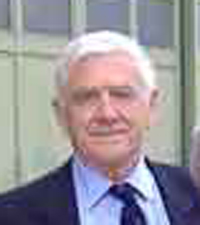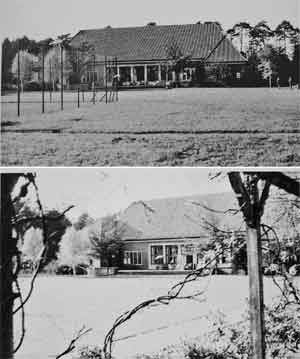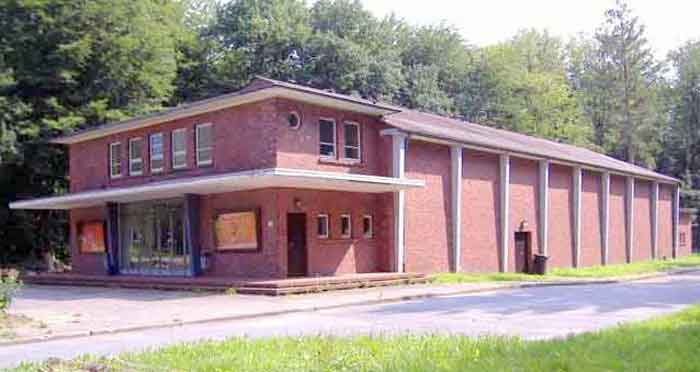
Dick Haynes on a Visit back to GAF Jever in August 2006

Way back in the 1950s when it was not the custom to "take a year off before or after Uni" National Service provided an excellent opportunity to broaden one's experience and travel: an opportunity which I was fortunate enough to be able to grasp with both hands.

National Service offered me two choices: the continuation of University Air Squadron pilot training, but with limited prospects of foreign travel, or the Airfield Construction Branch which promised the opportunity to further a possible Civil Engineering career with the certainty of an overseas posting to either Cyprus or Germany.

Career and foreign travel carried the day with the result that although my feet were firmly on the runway part of my heart was always in the sky and so recollections of the period January 1954 - October 1955 are tinged with experiences above ground level.

Church Lawford was my introduction into both practical Civil Engineering and the Nurses of Rugby Hospital. Later in Germany it transpired that a fellow
ACB Officer had escorted the same Nurse as I had but a year previously during his training. (She obviously had good taste.). One of the excellent instructors was
Robbie Roberts who later became my unit Squadron Leader at Jever.

After Church Lawford came an assignment to 5352 Wing of the
ACB in Germany and to RAF Jever. Many will recall the experience of the journey via the boat train from Liverpool Street to Harwich and then the troopship crossing of the North Sea to The Hook of Holland. From there troop trains branched out for destinations throughout Northern Europe. In my case a long journey through the Netherlands and North Germany and at last via Oldenburg, Jever.

The small town of Jever had been undamaged during the war and was famous for its Jever Pilsner beer. I recall very little fraternisation with the local population but most of the airfield civilians came from that town where the other ranks' married quarters were located. The airfield had formerly been in the Luftwaffe Fighter Command and was situated on the edge of Pine Forests a few miles from the town.

When I arrived in Jever in the Spring of 1954 the station commander was
Group Captain Powel-Sheddon who, in spite of suffering from a severe stutter which must have interfered with his cockpit communications, had been a Battle of Britain Ace. He is mentioned in the book "Reach for the Sky" which records the exploits of Douglas Bader.

The 5352 unit officers then were Squadron Leader Frank Jones and
Flying Officer Phil Westwall who soon afterwards moved onwards and upwards to Headquarters.

Amongst our
NCOs I recall Warrant Officers Storey and Bob Styles and Flight Sergeant Monty Montgomery. Our office was ruled by a very pleasant and efficient secretary, Frau Eppe.

Wing headquarters was near the larger town of Oldenburg some thirty miles away which was also an RAF Fighter Base. There was a gliding club on the Airfield and I spent many Sundays in the air again.

The
Station Commander was also keen on gliding and I recall on one still and windless day that he managed to manufacture thermals by having his jet squadrons rev their engines on the tarmac. Personally I thought that this was a case of pulling rank as we struggled to get off the ground at the far end of the airfield.

Oldenberg also was justly proud of its Opera House. It presented a wide repertory and I was introduced to many works that I had never previously enjoyed. In the intervals it was the custom for the audience to divide into couples and perambulate slowly in a clockwise direction in the main foyer. It soon became obvious that most of the couples were ladies and that the male population had been decimated; a sad reminder that the war was in the recent past.

Whilhemshaven was also within easy reach with a Services Sailing club alongside the destroyed submarine pens.

Hamburg was a Weekend Pass away with its Reeperbahn, famous for illicit delights. Personally I found that the spectacle of witnessing naked overweight German frauen wresting in mud palled very quickly but the Hamburg beer was good.

RAF Jever, was one of the more isolated stations in Germany but probably because of this it developed a wonderful spirit of enduring comradeship. For the single there was not the temptation or opportunity to go home at weekends and most sports were encouraged.

My Mess duty was that of Librarian. This involved devising a very free and easy system for borrowing and returning books and also the ordering of new books; which enabled me to order for my own account some personal books at greatly reduced cost which I can still identify on my shelves at home.

I also recall teaching sergeants O-Level maths for a promotion exam and I believe most were successful as they wanted to learn and so were easy to teach.
.

The 5352 unit was accepted as an integral part of the station and participated in all possible activities. However as a National Service officer it was suggested that I need not attend
CO's Station Parades. This was because my standard issue of uniform did not include a peaked cap but merely a beret which disturbed the pattern of a line of caps on the parade ground.

After the experience of somewhat basic accommodation in England the single officer's quarters were luxurious, built around a large lawn and tennis courts facing towards the
Officers' Mess.

The married quarters were very attractively located in tree lined avenues just outside the station main gate with a school nearby.

Tennis provided another avenue for me to get into the air again because, when playing away in inter station tennis matches, I often managed to persuade one of the tennis playing pilots to let me accompany him in the station twin seated T11 vampire trainer. With minimum luggage requirements it was merely necessary to open its nose to reveal a space which only seemed to contain a lead battery, and dump there our tennis bags. The experience of this flying compared with my Chipmunk days was like comparing a Rolls Royce with a model T Ford. The flights were relatively uneventful except on one occasion when the flaps failed and the overshoot gravel proved helpful.

The ACB Unit's major project in 1954 was to extend the single runway by 700yds to accommodate the new Hunter squadrons which were to replace Sabre Jets. The extension involved cutting swathes into the forest much to the dismay of the local population for whom the traditions of hunting and shooting were deeply ingrained in their annual "Schutzenfest" festival.

However I recall no lasting discord and some financial compensation together with liberal use of Jever Pilsner may literally have lubricated the relationship.

The Runway extension project was fascinating and was completed on time. The German contractors used a conveyor belt system of machines from pre-war autobahn construction units, which enabled the concrete to be laid down rapidly as if it were a carpet

A Panorama of the Runway Extension Train which was a German Pre-war autobahn construction unit. Note the concrete mixing plant in the background. This extension was built by the Airfield Construction Branch with Rathgens as Contractors. (Thanks to
Robbie Roberts for this picture).

Our resident German Consultant Dr Dr Blumenstein (apparently in Germany the single qualification of Dr was very inferior) taught me how to check the consistency of the mix. Too dry and it would crumble in the hand: too wet and it would slump (like "Schitzen" as he put it). The machinery was so interesting that I authorised photographs to be taken of the work in progress and stamped them with our Unit stamp which stated that they were secret or for restricted use. Later I will reveal how these photographs caused alarm at the Air Ministry.

The
ACB also provided my first introduction to the office procedures associated with any organisation. Green loose leaf folders appeared regularly from Wing headquarters and the enclosed memos had to be acted upon or merely noted for information but in any case a signature had to be applied for record purposes. What then happened to these files remained a mystery but Frau Eppe could always produce them, or their copies, when required. It was at this early stage that I developed a healthy scepticism regarding instructions from a higher authority because after reading a particular memorandum full of detailed and time consuming tasks which did not seem to recognise the realities of a particular situation I noticed that it had been signed off by a fellow member of my Church Lawford training school.

Our work also involved many minor projects of maintenance and small builder's construction and we were kept extremely busy.

In the Autumn of 1954 Frank Jones was replaced by
Squadron Leader Robbie Roberts who had been one of my Instructors at Church Lawford and life continued at a hectic but enjoyable pace. It was about this time that instructions and plans arrived from HQ giving us the authority and budget to build a cinema. This new entertainment facility was long overdue on our isolated station and the prospect was welcomed with enthusiasm.

However I was not too impressed by the plans which were for a standard Astra cinema which had been built on many RAF stations in the pre-war years. But now it was 1954 and wide screen Cinemascope with Stereophonic sound was being introduced into England. With the arrogance of youth I proposed to HQ that I could arrange for such a Cinema to be built at Jever within the allocated budget.
Squadron Leader Roberts backed me and HQ agreed.

I had a hidden ace up my sleeve in the person of Dr Dr Blumenstein with whom I had discussed the feasibility of the project. He had reacted enthusiastically and his depth of experience both in construction and general and acoustical engineering gave me the confidence to go ahead. Together we re-designed the structure, eliminating much of the facade which had no practical use. The interior walls had cladding of plastic with corrugations of amplitude to ensure the correct sound distribution. I was learning all the time and the main credit for the technical achievement should go to our Dr Dr Consultant. In a postscript to this account there is a note of interest relating to this cinema learned more than 50 years later.

Dr Dr and I also re-designed a sports pavilion but I had left the station before work started on this project.

Not all work was enjoyable and the worst experience was involved in clearing the remains of a
Sabre which had crashed into a field on the station landing circuit. I remember the unfortunate pilot well but cannot recall his name. The Medics had cleared his body before I was on the scene but details still had to be measured, partly for damage compensation caused to the field and its crops.

In the Spring of 1955 I was sent on detachment to Fassburg when the 5352 officer, Brian Long went on leave. If the accommodation at Jever had been good, that at Fassburg was palatial. I recall that I had a suite and squirrels, still red, cavorted in the woods outside the windows. This had been Goering's favourite station and no expense had been spared in considering his pilots' comforts. Here I had two Volkswagens with drivers at my disposal. One was for local station use and one was for the journey to Syldt which was a subsidiary unit.

After a brief return to Jever I was then posted to Berlin. In fact this was a very sought after posting and at first I thought that it might be as a reward for services rendered. I was later disillusioned when I learned because it was believed at HQ that I was keen on sailing and RAF Gatow was located amongst the lakes of West Berlin. In fact I had no interest in sailing but Berlin provided another varied experience.

A postscript to this rather rambling account of my RAF
ACB National Service experience was played out in the Summer of 2006 over fifty years later.

Then, in August, my wife and I joined a group of 51 former RAF Jever officers and their wives on a
visit to Jever at the invitation of the Station Commander and organised by
Mick Ryan. The party also included former 5352 officers and colleagues
Robbie Roberts and
Phil Westwell.

The Station is now the Headquarters of the German equivalent of the RAF Regiment and also provides a facility for breaking down and cannibalising various Jet fighters.

In his welcoming address the Station Commander remarked that some of the pre-war hangers built for the Luftwaffe were preserved as listed buildings by virtue of their advanced techniques and design of that period.

He added, almost as an after thought, that there was also a listed building on the station dating back to the RAF period. It was the Station Cinema!

How many listed buildings has the
ACB constructed I wonder and how many 23year olds have had the opportunity to design one?
And here it is




